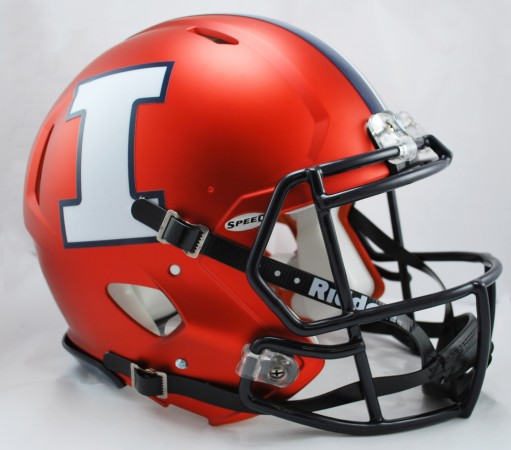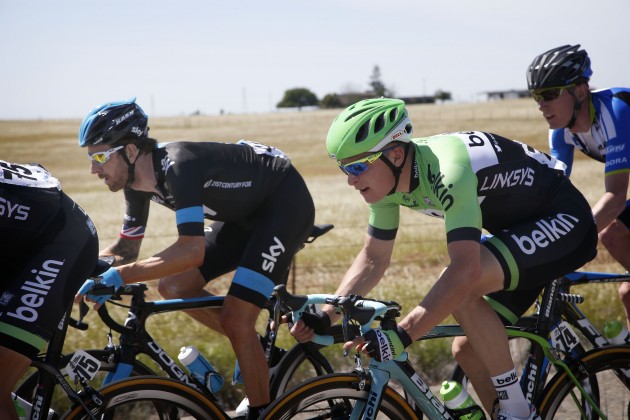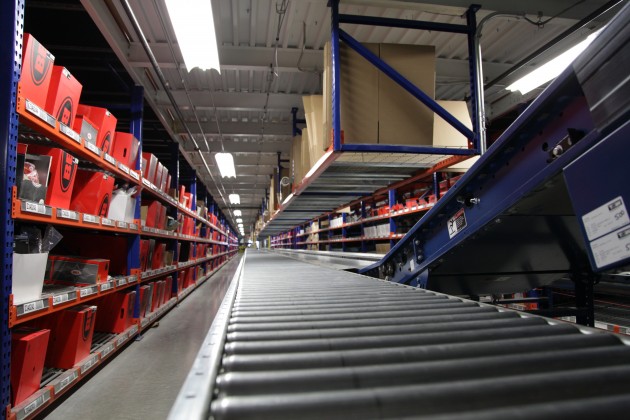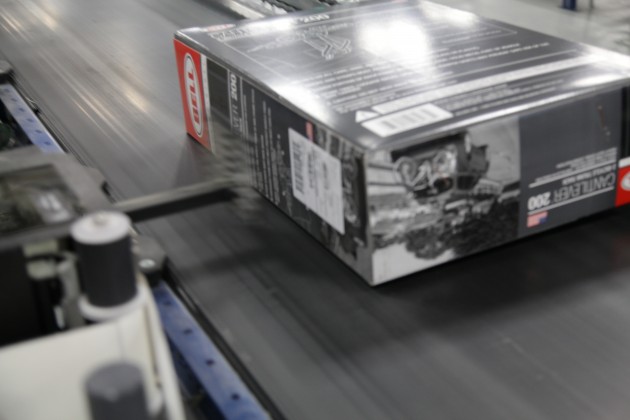
Consolidated DC automates omni-channel order fullfillment
By Patrick Roberts
Automation Coding & Labeling Controls/Drives Conveying Avison Young Competitive Insights DC distribution centers Easton-Bell Sports EBS Heitman Technologies RDS real-time distribution system SAP’s Warehouse Management Module Supply Chain Alliance cpnsortium The Numina GroupNew EBS (formerly known as Easton-Bell Sports) distribution center features high-speed pick, pack and ship automation, powered by Real-Time Distribution System, (RDS), a Tier-1 WCS, that simultaneously processes Internet to big box retailer orders and everything in between.
EBS (formerly known as Easton-Bell Sports) is a leading designer, developer and marketer of sport equipment and accessories that enhance athletic performance and protection.
The company has set the standard in action, power and team sports with brand names like Giro, Bell – America’s number-one brand in ski, snowboard, cycling and action sports helmets, Easton baseball and ice hockey equipment, Blackburn cycling accessories, and Riddell protective equipment and reconditioning services.
The backbone of the company’s success is rooted in its product design, engineering expertise and customer focus to market product innovations, such as developing the first protective cycling and auto racing helmets, and engineering the first football helmet to achieve the highest possible 5-STAR rating by Virginia Tech University.
These advancements have accelerated Easton-Bell Sports’ sales growth to four million Riddell football helmets and 13 million bicycle helmets annually, propelling the company’s revenues to over $825 million in 2012.
Need to Consolidate Distribution Facilities
Growth, brought about by both increased product sales and acquisitions over the past 10 years, created a fragmented distribution structure, spread out over five distribution locations in North America.
“We wanted more efficiency throughout our supply chain, including faster deliveries regardless of the customer product family order mix,” says Global Logistic vice-president Lewis Hornsby. “Our key operational goals and challenges were the integration of our supply chain and distribution order fulfillment operations across all our business units.”
Easton-Bell Sports distributes to multiple market channels, big box retailers, specialty, sports and cycling retailers as well as a growing volume in e-commerce orders.
Orders can range from 10,000 carton shipments fluid loaded to trailers down to a single item polybag shipment.
Approximately 70 percent of order volume is to retailers, consisting of full-trailer and mixed-case pallets.
The majority of these shipments require store/order Advanced Ship Notice (ASN) labeling on each carton, to meet the retailer’s purchase order item and for tracking level shipment specifications.
“Having different product inventory spread out over multiple distribution centers meant we frequently had to prepare multiple shipments from different centers to fulfill a customer’s order,” continues Hornsby. “It made good business sense to consolidate inventory and shipments to enable shipments from a single facility for both us and our customers.”
Moving Beyond Manual Order Processing
Consolidation of distribution operations and transportation cost savings were not the only factors considered.
The distribution processes were primarily based on man-to-goods, using fork trucks to perform manual picking of cases and ‘eaches’ from pallet positions.
Fork trucks dominated the operation, performing the product movement from receipt of inventory, through put-away, picking, packing, labeling and shipping.
The DC (distribution center) is managed by SAP’s Warehouse Management Module (WM). WM controls inventory and order picking processes.
“In the prior DCs, fork truck operators used RF terminals to record product movement, order tracking and record order item level details,” expresses Hornsby, adding that full cases were picked to pallet and brought to staging areas.
Operators manually broke down the pallets and reconstructed each pallet for a given retailer order. The operators generated a batch of order-specific ASN labels and hand applied the labels to the proper location for each carton. This required specific written instructions/rules for each customer, several products moves, multiple touches and inspection steps to ensure each carton received the proper order shipment compliance label.
Similarly, split-case, less-than-case shipments were picked to totes or pallets using fork trucks, then dropped at the pack station area. Following inspection at carton packing, shipments were separated for LTL and parcel shipping. Parcel orders moved on a conveyor line to a manual shipping manifesting station where cartons were again manually weighted and labeled for each carrier’s specific shipment.
The Easton-Bell Sports person-to-goods order fulfillment paradigm had a high level of success, but carried with it a high burden of multiple touches and wasted travel time leading to high costs per order.
With less than full-case orders increasing, and growing Internet orders, a more efficient pick pack and ship process was required to reduce fork truck picking. The changing order profiles seriously challenged the company’s traditional person-to-goods fulfillment model.
“E-commerce in 2012 represented a minor portion of our total orders, but that volume is increasing every year,” says Hornsby. “Our each-pick and pack requirements for both specialty retailers, such as specialty bike stores and e-commerce, both needed a leaner, faster process to meet the continued parcel shipment growth.
“Once we determined that pickers could spend up to 60 percent of their time traveling and only 40 percent of the time picking, we knew it was time to design new picking processes,” he continues.
“We wanted a solution that could give us two- to three-times more efficiency, minimizing wasted labor and increasing lines per picker. We were not sure what technology we needed, but we were determined to develop a more efficient operation to gain a competitive edge in the markets we serve.”
Strategically Locating the Central DC
Easton-Bell Sports had five distribution facilities spread out over North America. Determining a location to consolidate the company’s distribution operations was a prime objective. Much of the network strategy was conducted internally, but Easton-Bell brought in several strategic partners during the define, design and site selection phase.
“We had to analyze the impact and costs for all of our inbound and outbound transportation, this and several other complex factors needed to assessed,” states Hornsby. “There were so many different cost drivers that influenced where we should locate the central distribution facility. We didn’t have those internal capabilities to do all the data crunching work in a timely manner.”
Easton-Bell Sports retained the services of the Supply Chain Alliance, a consortium of companies aligned to provide turnkey solutions to supply-chain operations. The alliance includes Competitive Insights for strategic supply-chain data analysis and consulting services, Avison Young for real estate financial analysis services, Heitman Technologies for the facility design and modeling, and The Numina Group for the DC order fulfillment process design and automation services.
“Having a single team with complementary talents that managed all aspects of the project was very appealing to us,” relates Hornsby. “Analyzing the data for the facility site selection, real estate financial assessments, build-buy analysis, determining construction/facility costs, and the role automation could play in driving the ROI decision greatly aided us in the decision process. We were pleased with how the team worked together to integrate the entire project design and budget requirements.
“We felt like they complimented each other and were a good match for our needs.”
After a number of site assessments that analyzed distribution center locations based on the company’s customer population, ordering profiles, inbound and outbound transportation, labor availability, labor costs, municipal incentives and other factors, the final decision pointed to Easton-Bell Sports’ current geographic area—Rantoul, IL—as a top-ranked site for the new Easton-Bell Sports’ North American central distribution center.
Driving factors in selecting Rantoul were its central U.S. location, excellent crossroad access and rail transportation service.
The company has an operating history in the area dating back to 1983, including two distribution facilities and a manufacturing operation.
“The workforce ethic of the Central Illinois area, along with a current skilled labor pool, was critical in our decisions to keep manufacturing and logistics in Rantoul,” states Hornsby. “It allowed us to retain key employees and transition the operations in a phased move more cost effectively.”
The facility was designed as a multi-purpose operation to consolidate manufacturing, assembly, distribution and customer service for its market-leading sports brands, for marketing into the central and southern regions of the U.S.
Easton-Bell still retains several distribution centers located in the northeast, the western U.S. and Canada, to support distribution in those areas.
Defining and Designing the Facility
Once Rantoul was selected for the new operation, The Numina Group took the lead in defining and modeling the facility to finalize its size and processes to consolidated order fulfillment operations.
Numina’s engineering team worked closely with the Easton-Bell Sports operations and IT team to analyzed order profiles, shipment methods, inventory flow and business processes.
Numina also partnered with Heitman Architects to review the order- and item-cube data to develop a model for the facility size and overall project budget.
The team determined that an 813,000 square-foot facility (300,000 square-feet less than the initial analysis) would meet the five- to seven-year growth plan of the facility.
The facility planning includes approximately 33,000 square-feet of office space, and 780,000 square-feet for manufacturing, assembly and distribution.
The facility design included 36-foot-clear ceiling heights for pallet storage optimization, and the site was designed for expansion with up to 428,000 square-feet of future space.
Based on these projections, Avison Young went to work and located a Greenfield site. With the site selection and facility planning process complete, the facility groundbreaking was set for August 2012 and go-live in January 2013.
“Once the site selection and facility design was complete, we selected Peak Construction as our contractor to handle the site preparation and building,” says Hornsby. “We focused our efforts on how order fulfillment automation could positively impact our business. None of our current facilities, with the exception of manufacturing, had much automation except for some simple conveyor lines, so we wanted to uncover what type of processes and technologies we needed.
“Numina came back to us, after analyzing data from our distribution locations, and showed us an aggregated profile of what and how we shipped—something we had never done before.
“Armed with the new data, we explored several types of order fulfillment, conveyor designs and picking automation,” he continues. “We considered pick to light, batch-pick with put to light, staying with RF picking and voice-directed picking to determine which technology gave us the best accuracy and ROI (return on investment). The technology had to reduce picker travel time, increase fill rate accuracy and increase order processing speed.
“After an extensive evaluation of each technology, it was determined voice worked best and could be tailored to each operation.”
Automated Processes Designed for Integrated Omni-Channel Fulfillment
The Rantoul distribution center was designed and implemented from day one to operate as a highly flexible omni-channel order fulfillment operation.
Regardless of the mix of order types, processes were designed to support parallel pick, pack and ship operations for each order type.
It was determined that SAP would continue to manage the warehouse management and inventory duties. SAP WM using the current RF (radio frequency) terminals continues to manage the receiving, put-away, slotting, inventory and replenishment functions, and the WCS manages picking and report-back pick activity, and carton and full-case order level details to enable SAP to manage all of the inventory moves.
RF terminals at the receiving process are used to direct the unloading of containers and scan/put of like SKU (stock-keeping units) cartons to pallets for put-away.
The storage system includes a mixed-storage profile of 75 percent narrow aisles and 25 percent wide aisles.
The DC opened with 42,000 pallet locations in its current configuration, with the ability to expand to 60,000 locations.
SAP controls forward inventory moves to the storage locations throughout the split-case and full-case pick modules.
For the new DC, SAP required several enhancements from the Easton-Bell IT (information technology) staff to build and release order waves to support the automated order fulfillment processes.
To support the new operations, a warehouse control system (WCS) was required to further execute wave order optimization, manage the new picking processes and material handling controls.
The WCS includes order-release logic to balance work flow throughout the fulfillment center, for voice picking, cartonization for picking direct to carton, automated packing, and print and apply labeling.
Tier-1 Warehouse Control System
At the core of Rantoul’s omni-channel fulfillment operation is the DC’s WCS that extends functionality beyond traditional warehouse control systems.
It includes an integral order fulfillment automation module that orchestrates and balances the work across the fulfillment center’s various processes. The sophisticated WCS simultaneously runs the entire mix of the order fulfillment processes.
The WCS is The Numina Group’s Real-time Distribution System, RDS, which provides a modular family of pre-developed application control functions (modules) for pick, pack and ship functions.
RDS includes voice-picking for all the pick processes, conveyor and sorting control, packing, and automatic print-and-apply labeling to integrate the control and execution of all the order fulfillment processes. The
Tier-1WCS (RDS) fully-integrates all of the order fulfilment processes and material handling control.
The Rantoul DC automation modules include, order release and work balancing, voice-directed picking, conveyor control with carton zone routing, and high-speed sortation controls.
Additional automation throughout the center includes weigh-cube/dimension, in-line print-and-apply labeling literature and insertion, order validation, and labor order detail tracking and reporting.
The real-time order fill processes also enable real-time reporting.
“The WCS reporting is very important to us,” explains Hornsby. “This is a big improvement for our management and complements the capabilities of SAP WM. We can now spot difficulties more rapidly using indicators and alerts from the WCS, and resolve them quickly.
“All picking and order movement operations can be tracked with web screens or from a hand-held wireless terminal. Managers can view operational data and handle situations quickly from the floor. We also manage and now report labor differently.
“The WCS allows us to track labor for each operator based on the work task function and we are able to allocate our workers more efficiently,” notes Hornsby.
To ensure rapid control processing speeds for the conveyor, sorters and material handling automation, RDS contains a control language called Trak, a versatile multi-function, event-based control engine that performs real-time control, fully integrated with data driven order fulfillment rules with control logic, executed in a real-time extension at 250 microsecond speeds.
Voice Picking
The picking is managed by The Numina Group’s RDS voice-directed picking throughout the DC.
The Rantoul DC workers wear a headset and a wireless belt-mounted speech recognition PDA with a hands free barcode scanner.
A key advantage of the voice system is its speaker independent, zero voice training technology.
It requires no operator voice training regardless of accents or languages. Operators are productive in minutes so even temporary workers can be trained in 10 minutes or less.
This is how the system works:
- a) an assignment from the WCS is transmitted to the picker’s PDA, a small, lightweight industrial wireless RF computer which translates work assignment data as audible voice commands;
- the picker hears instructions and identifies to the pick location, eyes focused and hands free;
- the picker uses a hands-free ring scanner to scan the location and check the digit barcode or the SKU item ID at the product storage location;
- the picker can also be directed to scan or voice verify correct product or scan serial numbers. Following item verification, the operator is prompted with a voice command to perform the required item quantity pick, and voice commands confirm the actions taken;
- verbal responses are translated to data and transmitted back to the WCS and SAP, and;
- the picker then receives the next pick assignment. The voice system eliminates the complexity of traditional voice technologies and the need for pre-printing pick sheets, labels or RF screens to read or key-in pick quantities. Operators pick with both hands instead of just one. Operators simply listen, scan pick and speak the quantity confirmation.
“The time it takes to get an employee up to speed with voice picking, versus what we did before, is unbelievable,” mentions Hornsby. “Before, they had to read instructions, scan and key-in pick quantities, and know where and what to put to each order shelf/tote, and once complete where to bring orders for consolidation.
“The accuracy was not high enough so each order included secondary inspection.
“The voice system does all the logic for them. It directs them in the shortest pick path to the right location, and directs the pick and items verification directly to the correct size carton. They confirm the picks by scanning the item and quantity picked, and then directed to place pick-completed cartons on the powered conveyor. No special training, it is remarkably easy and highly accurate allowing a single touch pick-and-pack validation that has eliminated the vast majority of our secondary inspection processes.”
Parallel Pick, Pack and Ship Processes
Several voice-directed picking processes are at play in the Rantoul DC:
a) three-level full-case pick modules, complemented by a high-volume full-case assembly conveyor line, allow two paths for full-case order picking direct to conveyor;
b) dual two-level pick modules support the split-case storage and picking.
In the pick modes, items are slotted to carton flow, pallet and shelf locations based on movement analysis. The pick modules provide locations for picking the top 80 percent of the SKUs. The operation uses over two miles of automated conveyor, and three high-speed sorters to manage the carton flow throughout the distribution center.
The Numina Group teamed with TGW to design and implement the conveyor and sorting system. TGW provided the final detailed hardware selection matched to each area’s throughput requirements, along with the installation services to manage the movement of cartons.
In the split-case modules, the WCS determines each order start zone and uses cartonization logic to cube items and select the right size carton.
Voice directs the operator to select the proper carton size and scans a carton LP barcode used to marry the carton to the order. The modules use conveyors with cartons traveling and routed based on a carton LP barcode.
Barcode scanners at each zone route the cartons to any of the 37 pick zones. Cartons only stop at zones requiring a pick, and once the picks are complete at a zone/level the carton exits onto the early-out order routing sorter direct to the other modules or directly to the automated packing mezzanine.
Slower moving SKU’s slotted outside of the modules use the same cartonization logic with voice-directed batch-picking carts, or reach trucks that can contain up to 20 cartons.
The pickers in these areas are directed on the most efficient work path, and voice directs the pick and put-to-carton with scan validation following the same logic deployed in the pick modules.
Once the operator completes the cart picking, voice directs the operator to unload cartons on a conveyor-induct line at the pick module.
If cartons require an item slotted in any of the 37 pick zones, the carton follows the same zone-rout logic and voice directs the picking of higher-volume SKUs to the cartons.
Ninety-three percent of all SKUs in the DC are processed through the automated conveyor picking and sorting system, with WCS logic that seamlessly integrates the order fulfillment process.
Larger items, deemed non-conveyable, are voice picked and processed using carts and trucks, and directed to an order consolidation lane at shipping.
Regardless of the order mix of full-case or split-case orders, cartons are picked using voice-directed picking technology.
Packing
Completed pick orders are conveyed to the third floor mezzanine located above the pick modules, and are sorted to pack lines or the value-added area. At each pack line, the carton barcode is scanned and a message display directs the operator the carton-pack task requirements, and the required pack sheet documentation is automatically printed and inserted.
Once packing is complete, cartons travel to an in-line scan-weigh scale and the weight is transmitted to the shipping manifest system to obtain the required shipping label.
Cartons then convey to one of three in-line scan tunnels that include print-and-apply labeling.
Auto Print-and-Apply Labeling
Full-case picking conveys from the three-level case-pick module, or the assembly floor area slapper conveyor lines.
These cartons travel to the pack mezzanine labeling area and are metered through the scan tunnel, and automatic print-and-apply labeling process.
The auto print-and-apply labeling includes dual Panther Industries all-electric applicators, each capable of auto-labeling 30-plus cartons-per-minute.
At each line, the carton SKU or LP barcode applied in the split-case pick module is scanned to validate the pick and automate the shipment labeling process.
If the carton is a parcel shipment, the UPS or Fed Ex label is printed, applied and verified to the top of each carton.
The DC’s highest carton volume orders are the full-trailer loads to big box retailers, and large pallet shipments to major sporting retailers. Both of these shipment types require each carton to contain an ASN-compliance label.
In the old DC, this operation was a manual batch-print and hand-apply process, a highly labor-intense operation.
Voice now manages the batch-picking of the cartons direct to conveyor, and the scan tunnels and print-and-apply applicators automate the carton ASN labeling.
Regardless of the carton/order origination, from either split-case pack completed cartons or the full-case pick to conveyor areas, all cartons flow through the same scan verification and auto-labeling lines.
The scan and labeling process provides validation prior to cartons conveying to the consolidated shipping area.
Shipping
Labeled and ready-ship cartons transport from the mezzanine to the high-speed shipping sorter at up to 150 CPM.
The shipping sorter is a TGW Wave Sorter, a high-speed narrow-belt technology which provides the performance of a shoe-type sorter but at a substantially lower cost.
The sorter directs cartons to carrier-specific powered spiral conveyor lanes for UPS or FedEx, or to pallet-build lanes for retail LTL shipments, or to power-extendable conveyors for the fluid-load, full- trailer shipments.
Again, voice and hands-free scanning is used to direct operators at the LTL pallet-build lanes, to scan and put cartons to the proper pallets.
Workers with voice-directed headsets then scan the carton labels, and are voice directed to the proper pallets.
Additionally, non-conveyable items are voice picked using fork trucks and synchronized with the case-pick conveyor processes. These items are directed to the proper customer LTL pallet staging area.
Going Live
The Rantoul distribution center testing went live in November, 2013.
The switchover was phased in gradually over a period of six weeks.
“We really had no problems with going live,” Hornsby relates. “We started off very methodically and purposely overstaffed because we wanted our workers to visually look at the orders and make sure that there were no errors. Going from a manual operation to an automated system, we really did not know what to expect.”
The DC’s design for the initial phase was to support 100 cartons-per-minute (CPM) mixed full-case order shipments and 125 CPM combined full-cases/split-cases.
In the future, the conveyor system speed can be increased 20 percent, or more, to increase throughput.
“After two months, we are already approaching a significant throughput improvement,” Hornsby states. “We are very pleased and see the opportunity to exceed our goals as we continue to consolidate the other operations and ramp up the DC.”
About Easton-Bell Sports, Inc.
Easton-Bell Sports, Inc. is a leading designer, developer and marketer of sport equipment and accessories that enhance athletic performance and protection. With Easton, Bell, Riddell, Giro and Blackburn, the company’s brand portfolio sets the standard for innovation and excellence in baseball, softball, ice hockey, football, lacrosse and cycling as well as snow, action and power sports. For over 80 years, sports enthusiasts at all levels have selected Easton-Bell products for their innovative designs and advanced materials.
The company is headquartered in Van Nuys, CA and operates 32 facilities in the U.S., Canada, Mexico, Europe and Asia. For more information, contact Lewis Hornsby, vice-president Global Logistics, Easton-Bell Sports, Inc.; 7855 Haskell Avenue, Suite 200, Van Nuys, CA 91406; or via e-mail at lhornsby@eastonbellsports.com; or visit www.eastonbellsports.com.
About The Numina Group
With over 27 years of experience in warehouse and distribution design and automation, The Numina Group provides design, engineering and turnkey project implementation to improve product storage, picking, packing and shipping order fulfillment operations. The company delivers proven strategies to streamline operations at both existing and new distribution centers. Services encompass warehouse control systems, picking, packing and shipping order fulfillment automation, and conveyor and material handling hardware for turn-key automated distribution operations to eliminate bottlenecks, excessive labor and improve operation profitability.
The Numina Group’s Real-Time Distribution Software System (RDS) is the industry’s most powerful and scalable Tier-1 warehouse control system (WCS) with a complete family of automation modules to seamlessly integrate pick, pack and ship order fulfillment processes with conveyor controls, robots and sorting applications into a unified system architecture.
For more information contact Patrick Hanrahan, Marketing Coordinator for The Numina Group; 10331 Werch Drive, Woodridge, IL 60517. Contact by phone 630-343-2600; via e-mail at phanrahan@numinagroup.com; or visit the company website at www.numinagroup.com.
Advertisement






